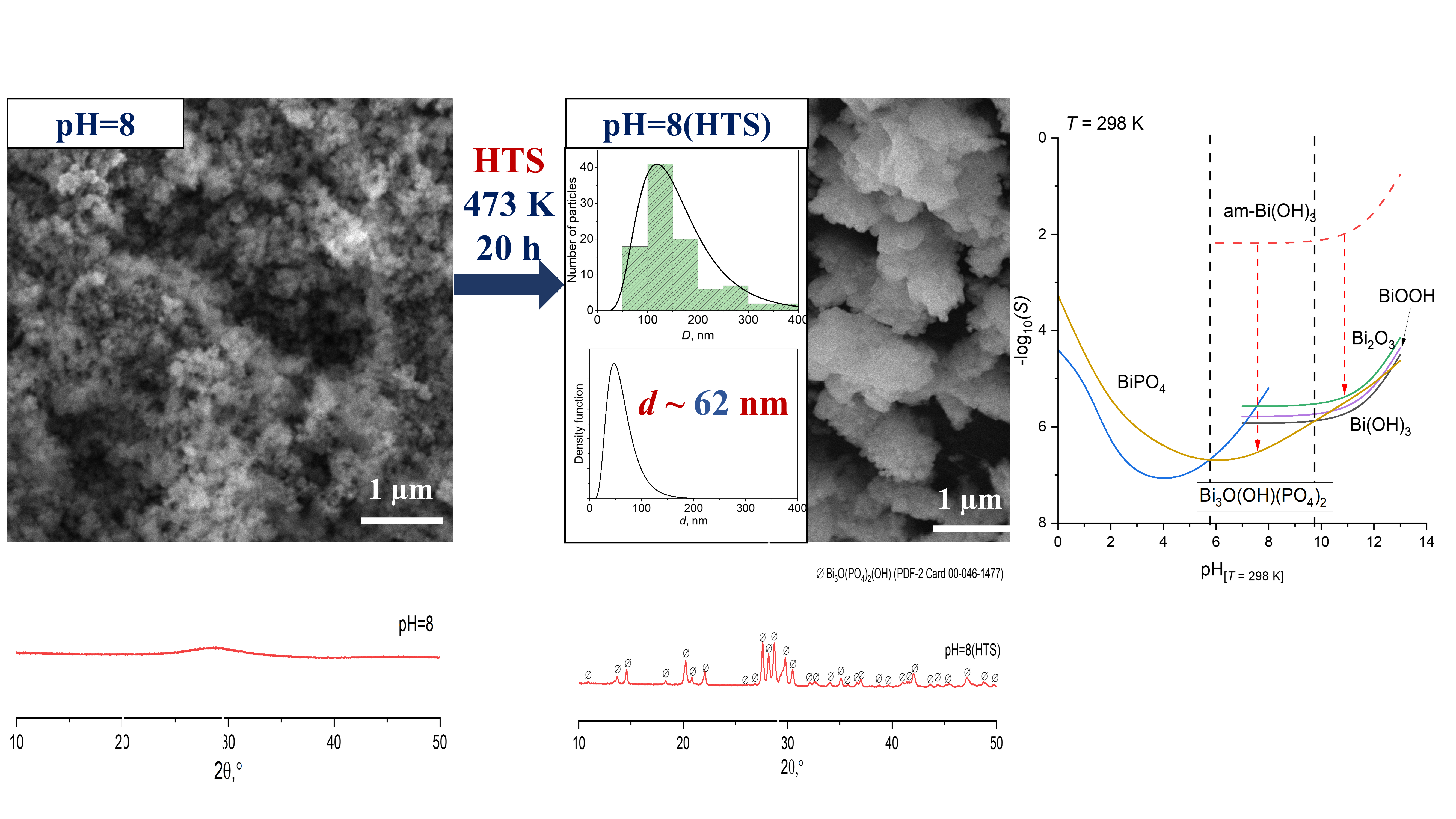Nanosystems: Phys. Chem. Math., 2024, 15 (3), 361–368
The role of the reaction medium pH in the formation of nanocrystalline phases in the Bi2O3–P2O5–H2O system
Dmitry P. Elovikova – Grebenshchikov Institute of Silicate Chemistry, Russian Academy of Sciences, St. Petersburg, Russia; syncdima@mail.ru
Alena A. Osmininab – Grebenshchikov Institute of Silicate Chemistry, Russian Academy of Sciences, St. Petersburg, Russia; alenaosminina3001@gmail.com
Corresponding author: Dmitry P. Elovikov, syncdima@mail.ru
DOI 10.17586/2220-8054-2024-15-3-361-368
ABSTRACT The work is devoted to studying the influence of pH values in an aqueous-salt medium on the formation of compounds in the Bi2O3–P2O5–H2O(OH-, H+) oxide system. It has been shown that in an acidic environment (pH = 2) at a temperature of 298 K, hexagonal BiPO4 forms, while at pH values of 8 and 12, X-ray amorphous substances are produced. After hydrothermal treatment at 473 K in an aqueous-salt environment, a monoclinic modification of bismuth phosphate forms from hexagonal bismuth phosphate in an acidic environment, and nanometer-sized particles of crystalline compounds Bi3O(OH)(PO4)2 (with a crystallite size of about 62 nm) and Bi2O3 (with a crystallite size of about 70 nm) form in weakly alkaline and alkaline media. Using the method of thermodynamic calculation, the dependences of the equilibrium molar solubility of these crystalline compounds on the pH value of the aqueous-salt suspension were obtained. Thermodynamic calculations showed that the BiPO4 compound is stable in the pH range from 0 to 5.8 at temperatures of 298 and 473 K. The pH range from 5.8 to 9.8 is characterized by the formation of the Bi3O(OH)(PO4)2 compound at 298 K, and a further increase in the pH value leads to the precipitation of Bi2O3, BiOOH or Bi(OH)3, which are similar in solubility, at 298 and 473 K. The data obtained from thermodynamic calculations are consistent with experimental data on the stability boundaries of BiPO4, Bi3O(OH)(PO4)2, and Bi2O3 compounds.
KEYWORDS nanocrystals, BiPO4, Bi3O(OH)(PO4)2, influence of pH value, solubility, thermodynamic calculation, hydrothermal synthesis
ACKNOWLEDGEMENTS The work was supported by state assignment No. 1023032900322-9-1.4.3. Elemental analyses of samples were performed employing the equipment of the Engineering Center of the St. Petersburg State Institute of Technology. The X-ray structural studies of the samples were carried out using the DRON-8 diffractometer at the Ioffe Institute.
FOR CITATION Elovikov D.P., Osminina A.A. The role of the reaction medium pH in the formation of nanocrystalline phases in the Bi2O3–P2O5–H2O system. Nanosystems: Phys. Chem. Math., 2024, 15 (3), 361–368.
[In Russian] Д.П. Еловиков, А.А. Осминина
Роль pH реакционной среды в образовании нанокристаллических фаз в системе Bi2O3-P2O5-H2O
УДК 546.87:542.06:544.351.3.032.73
АННОТАЦИЯ Работа посвящена изучению влияния величины pH водно-солевой среды на формирование соединений в оксидной системе Bi2O3 – P2O5 – H2O(OH-, H+). Показано, что в кислой среде (pH = 2) при температуре 298 K формируется гексагональный BiPO4, тогда как при pH = 8 и 12 образуются рентгеноаморфные вещества. Показано, что после гидротермальной обработки при 473 K в водно-солевой среде из гексагонального фосфата висмута в кислой среде образуется моноклинная модификация фосфата висмута, а в слабощелочной и щелочной средах из аморфных предшественников образуются наноразмерные частицы кристаллических соединений Bi3O(OH)(PO4)2 (с размером кристаллитов около 62 нм) и Bi2O3 (с размером кристаллитов около 70 нм). Методом термодинамического расчета получены зависимости равновесной молярной растворимости этих кристаллических соединений от величины pH водно-солевой суспензии. Термодинамический расчет показал, что соединение BiPO4 является устойчивым в интервале pH от 0 до 5.8 при температуре 298 и 473 K. Для интервала pH от 5.8 до 9.8 характерно образование соединения Bi3O(OH)(PO4)2 при 298 K, а дальнейшее повышение величины pH приводит к выпадению близких по растворимости Bi2O3, BiOOH или Bi(OH)3 при 298 и 473 K. Полученные, путем термодинамического расчета данные согласуются с экспериментальными данными о границах устойчивого существования соединений BiPO4, Bi3O(OH)(PO4)2 и Bi2O3.
КЛЮЧЕВЫЕ СЛОВА нанокристаллы, BiPO4, Bi3O(OH)(PO4)2, влияние величины pH, растворимость, термодинамический расчет, гидротермальный синтез.
